The Importance of Different Biomes (Atlantic Forest, Cerrado, and Caatinga) in the Regional Structuring of Neotropical Dragonfly Assemblages
Abstract
1. Introduction
2. Materials and Methods
2.1. Study Area
2.2. Specimen Collection and Identification
2.3. Environmental and Spatial Variables
2.4. Spatial Variables
2.5. Data Analysis
3. Results
Spatial and Environmental Variables
4. Discussion
5. Conclusions
Supplementary Materials
Author Contributions
Funding
Institutional Review Board Statement
Data Availability Statement
Acknowledgments
Conflicts of Interest
References
- Colwell, R.K. Biodiversity: Concepts, patterns, and measurement. Prin. Guide Ecol. 2009, 663, 257–263. [Google Scholar]
- Cortezzi, S.S.; Bispo, P.C.; Paciencia, G.P.; Leite, R.C. Influence of human action on the fauna of aquatic macroinvertebrates in streams in a cerrado region in the southwest of the state of São Paulo. Iheringia Sér Zool. 2009, 99, 36–43. [Google Scholar] [CrossRef]
- Brown, J.H. Why are there so many species in the tropics? J. Biogeogr. 2014, 41, 8–22. [Google Scholar] [CrossRef]
- Bo, T.; Doretto, A.; Levrino, M. Contribution of beta diversity in shaping stream macroinvertebrate communities among hydro-ecoregions. Aquat. Ecol. 2020, 54, 957–971. [Google Scholar] [CrossRef]
- Harrison, S. Local and regional diversity in a patchy landscape: Native, alien, and endemic herbs on serpentine. Ecology 1999, 80, 70–80. [Google Scholar] [CrossRef]
- Hubbell, S.P. The Unified Neutral Theory of Biodiversity and Biogeography; Princeton University Press: Princeton, NJ, USA, 2001. [Google Scholar]
- Heino, J.; Alahuhta, J. Elements of regional beetle faunas: Faunal variation and compositional breakpoints along climate, land cover and geographical gradients. J. Anim. Ecol. 2015, 84, 427–441. [Google Scholar] [CrossRef]
- Peres, C.A. Structure and special organization of an Amazonian terra firme forest primate community. J. Trop. Ecol. 1993, 9, 259–279. [Google Scholar] [CrossRef]
- Heino, J. Positive relationship between regional distribution and local abundance in stream insects: A consequence of niche breadth or habitat niche position? Ecography 2005, 28, 483–494. [Google Scholar] [CrossRef]
- Heino, J.; Grönroos, M. Untangling the relationships among regional occupancy, species traits and niche characteristics in stream invertebrates. Ecol. Evol. 2014, 4, 1931–1942. [Google Scholar] [CrossRef]
- Oliveira-Junior, J.M.B. Structuring of the Odonata (Insecta) Community in Eastern Amazonia: Spatial, Environmental and Morphological Effects in Intact and Altered Streams. Doctoral Thesis, Federal University of Pará/Museu Paraense Emílio Goeldi, Belém, Brazil, 2015; 163p. [Google Scholar]
- Harris, P.T. Biogeography, Benthic Ecology, and Habitat Classification Schemes. In Seafloor Geomorphology as Benthic Habitat; Elsevier: Amsterdam, The Netherlands, 2012; pp. 61–91. [Google Scholar]
- Mittermeier, R.A.; Tumer, W.R.; Larsen, F.W.; Brooks, T.M.; Gascon, C. Global Biodiversity Conservation: The critical role of hotspots. In Biodiversity Hotspots: Distribution and Protection of Conservation Priority Areas; Zachos, F.E., Habel, J.C., Eds.; Springer: Berlin/Heidelberg, Germany, 2011; pp. 3–22. [Google Scholar]
- Myers, N.; Mittermeier, R.A.; Mittermeier, C.G.; Fonseca, G.A.B.; Kent, J. Biodiversity hotspots for conservation priorities. Nature 2000, 403, 853–858. [Google Scholar] [CrossRef]
- Mello, K.; Taniwakir, H.; De Paula, F.R.; Valent, R.A.; Randhir, T.O.; Macedo, D.R.; Leal, C.G.; Rodrigues, C.B.; Hughes, R.M. Multiscale land use impacts on water quality: Assessment, planning, and future perspectives in Brazil. J. Environ. Manag. 2020, 270, 110879. [Google Scholar] [CrossRef] [PubMed]
- Klink, C.A.; Machado, A.R.B. Conservation of the Brazilian Cerrado. Conserv. Biol. 2005, 19, 707–713. [Google Scholar] [CrossRef]
- Ribeiro, M.C.; Metzger, J.P.; Martensen, A.C.; Ponzoni, F.J.; Hirota, M.M. The Brazilian Atlantic Forest: How much is left, and how is the remaining forest distributed? Implications for conservation. Biol. Conserv. 2009, 142, 1141–1153. [Google Scholar] [CrossRef]
- Scarano, F.R.; Ceotto, P. Brazilian Atlantic Forest: Impact, vulnerability, and adaptation to climate change. Biodivers. Conserv. 2015, 24, 2319–2331. [Google Scholar] [CrossRef]
- Brasil, L.S.; Vieira, T.B.; Oliveira Junior, J.M.B.; Dias-Silva, K.; Juen, L. Elements of metacommunity structure in Amazonian Zygoptera among streams under different spatial scales and environmental conditions. Ecol. Evol. 2017, 7, 3190–3200. [Google Scholar] [CrossRef]
- Chesters, D.; Beckshäfer, P.; Orr, C.M.; Adamowicz, J.S.; Chun, K.P.; Zhu, C.D. Climatic and vegetational drivers of insect beta diversity at the continental scale. Ecol. Evol. 2019, 9, 13764–13775. [Google Scholar] [CrossRef]
- Cardoso, P.; Parton, P.S.; Berkhofer, K.; Chichorro, F.; Deacon, C.; Fartmann, T.; Fukushima, C.S.; Gaigher, R.; Habel, J.C.; Hallmann, C.A.; et al. Scientists’ Warning to humanity on insect extinctions. Biol. Conserv. 2020, 242, 108426. [Google Scholar] [CrossRef]
- Gómez-Tolosa, M.; Rivera-Velázquez, G.; Rioja-Paradela, T.M.; Mendoza-Cuenca, L.F.; Tejeda-Cruz, C.; López, S. The use of Odonata species for environmental assessment: A meta-analysis for the Neotropical region. Environ. Sci. Pollut. Res. 2021, 28, 1381–1396. [Google Scholar] [CrossRef]
- De Marco, P., Jr.; Vianna, D.M. Distribuição do esforço de coleta de Odonata no Brasil—Subsídios para escolha de áreas prioritárias para levantamentos faunísticos. Lundiana 2005, 6, 13–26. [Google Scholar] [CrossRef]
- Carvalho, G.F.; Roque, O.F.; Barbosa, L.; Montang, A.L.F.; Juen, L. Oil palm plantation is not a suitable environment for most forest specialist species of Odonata in Amazonia. Anim. Conserv. 2018, 21, 526–533. [Google Scholar] [CrossRef]
- Rodrigues, M.E.; Roque, F.O.; Quintero, J.M.O.; Pena, J.C.C.; Sousa, D.C.; De Marco, P.J. Neolinear responses in damselfly community along a gradient of habitat loss in a savana landscape. Biol. Conserv. 2016, 194, 113–120. [Google Scholar] [CrossRef]
- Rodrigues, M.E.; Moura, E.B.; Koroiva, R.; Borges, A.C.P.; de Oliveira Roque, F. Survey of Dragonflies (Odonata) in Palm Swamps of Cerrado Hotspot. Entomol. New 2018, 128, 24–38. [Google Scholar] [CrossRef]
- Velloso, A.L.; Sampaio, E.V.S.B.; Pareyn, F.G.C. Ecorregiões: Propostas Para o Bioma Caatinga; PNE, The Nature Conservancy do Brasil: Brasília, Brazil, 2002; 76p, ISBN 8573151811. [Google Scholar]
- Cassano, C.R.; Schroth, G.; Faria, D.; Delabie, J.H.; Bede, L. Landscape and farm scale management to enhance biodiversity conservation in the cocoa producing region of southern Bahia, Brazil. Biodivers. Conserv. 2009, 18, 577–603. [Google Scholar] [CrossRef]
- Santos, L.R.; Rodrigues, M.E. Dragonflies (Odonata) in cocoa growing areas in the Atlantic Forest: Taxonomic diversity and relationship with environmental and spatial variables. Diversity 2022, 14, 672. [Google Scholar] [CrossRef]
- Lima, L.B.; Pimenta, F.M.; Silva, E.A.D.; Santos, A.B.; Costa, M.H. Spatial and temporal analysis of agricultural expansion in western Bahia. In Proceedings of the XXVII Brazilian Cartography Congress and XXVI Exposicarta, SBC, Rio de Janeiro, Brazil, 6–9 November 2017; pp. 1280–1283. [Google Scholar]
- Garrison, R.W.; Von Ellenrieder, N.; Louton, J.A. Damselfly Genera of the New World: An Illustrated and Annotated Key to the Zygoptera; The Johns Hopkins University Press: Baltimore, MD, USA, 2010. [Google Scholar]
- Lencioni, F.A.A. The Damselflies of Brazil: An Illustrated Guide—The Non Coenagrionidae families; All Print Editora: São Paulo, Brazil, 2005. [Google Scholar]
- Lencioni, F.A.A. The Damselflies of Brazil: An Illustrated Guide—Coenagrionidae; All Print Editora: São Paulo, Brazil, 2006. [Google Scholar]
- Nessimian, J.L.; Venticinque, E.; Zuanon, J.; De Marco, P.; Gordo, M.; Fidelis, L.; D’arc Batista, J.; Juen, L. Land use, habitat integrity, and aquatic insect assemblages in Central Amazonian streams. Hydrobiologia 2008, 614, 117–131. [Google Scholar] [CrossRef]
- Oliveira-Junior, J.M.B.; Juen, L. The Zygoptera/Anisoptera Ratio (Insecta: Odonata): A New Tool for Habitat Alterations Assessment in Amazonian Streams. Neotrop. Entomol. 2019, 48, 552–560. [Google Scholar] [CrossRef]
- Brasil, L.S.; Lima, E.L.; Spigoloni, Z.A.; Ribeiro-Brasil, D.R.G.; Juen, L. The habitat integrity index and aquatic insect communities in tropical streams: A meta-analysis. Ecol. Indic. 2020, 116, 106495. [Google Scholar] [CrossRef]
- Cunha, E.J.; Assis, L.M.F.; Juen, L. Oil palm crops effects on evironmental integrity of Amazonian streams and Heteroptera (Hemiptera) species diversity. Ecol. Indic. 2015, 52, 422–429. [Google Scholar] [CrossRef]
- Calvão, L.B.; Nogueira, D.S.; Montag, L.F.A.; Lopes, M.A.; Juen, L. Are Odonata communities impacted by conventional or reduced impact logging? Ecol. Manag. 2016, 382, 143–150. [Google Scholar] [CrossRef]
- Valente-Neto, F.; de Oliveira Roque, F.; Rodrigues, M.E.; Juen, L.; Swan, C.M. Toward a practical use of Neotropical odonates as bioindicators: Testing congruence across taxonomic resolution and life stages. Ecol. Indic. 2016, 61, 952–959. [Google Scholar] [CrossRef]
- Valente-Neto, F.; Rodrigues, M.E.; Roque, F.O. Selecting indicators based on biodiversity surrogacy and environmental response in a riverine network: Bringing operationality to biomonitoring. Ecol. Indic. 2018, 94, 198–206. [Google Scholar] [CrossRef]
- Jackson, D.A. Stopping rules in principal components analysis, a comparison of heuristical and statistical approaches. Ecology 1993, 74, 2204–2214. [Google Scholar] [CrossRef]
- Dray, S.; Legendre, P.; Blanchet, G. Packfor: Forward Selection with Permutation (Canoco p. 46). R-Forge, The R Project for Statistical Computing 2016. Available online: https://rdrr.io/rforge/packfor/ (accessed on 12 October 2022).
- Dray, S.P.; Legendre, P.; Peres-Neto, P.R. Spatial modelling, a comprehensive framework for principal coordinate analysis of neighbour matrices (PCNM). Ecol. Model. 2006, 196, 483–793. [Google Scholar] [CrossRef]
- Cunha, E.J.; Juen, L. Environmental drivers of the metacommunity structure of insects on the surface of tropical streams of the Amazon. Austral Ecol. 2020, 45, 586–595. [Google Scholar] [CrossRef]
- Dray, S.; Blanchet, G.; Borcard, D.; Guenard, G.; Jombart, T.; Larocque, G.; Legendre, P.; Madi, N.; Wagner, H.H.; Dray, M.S. Package ‘adespatial’. R. Package 2018, 2018, 3–8. [Google Scholar]
- Blanchet, G.F.; Legendre, P.; Borcard, D. Forward Selection of Explanatory Variables. ESA J. 2008, 89, 2623–2632. [Google Scholar] [CrossRef]
- Anderson, M.J.; Walsh, D.C.I. PERMANOVA, ANOSIM, and the mantel test in the face of heterogeneous dispersions: What null hypothesis are you testing? Ecol. Monogr. 2013, 83, 557–574. [Google Scholar] [CrossRef]
- Legendre, P.; Legendre, L. Numerical Ecology; Elsevier: Amsterdam, The Netherlands, 2012. [Google Scholar]
- Juen, L.; De Marco, P. Dragonfly endemism in the Brazilian Amazon: Competing hypotheses for biogeographical patterns. Biodivers. Conserv. 2012, 21, 3507–3521. [Google Scholar] [CrossRef]
- Juen, L.; De Marco, P. Odonate biodiversity in terra-firme forest streamlets in Central Amazonia: On the relative effects of neutral and niche drivers at small geographical extents. Insect Conserv. Divers. 2011, 4, 265–274. [Google Scholar] [CrossRef]
- Renner, S.; Périco, E.; Dalzochio, M.S.; Sahlém, G. The balance of common vs. rare: A study of dragonfly (Insecta: Odonata) assemblages is the Brazilian Pampa biome. Neotrop. Biodivers. 2022, 8, 188–199. [Google Scholar] [CrossRef]
- De Marco, P.; Batista, J.D.; Cabette, H.S.R. Community assembly of adult odonates in tropical streams: An ecophysiological hypothesis. PLoS ONE 2015, 10, e0123023. [Google Scholar] [CrossRef] [PubMed]
- Martins, F.A. Determinants of Odonata Diversity in Brazil: An Approach at Different Spatial Scales. Doctoral Thesis, Federal University of Goiás, Goiânia, Brazil, 2016. [Google Scholar]
- Ribeiro, C.; Rodrigues, M.E.; Shalén, G.; de Oliveira Roque, F. Dragonflies within and outside protected area: A comparison revealing the role of well-preserved atlantic forests in the preservation of critically endangered, phytotelmatous species. J. Insect Conserv. 2022, 26, 27–282. [Google Scholar] [CrossRef]
- Fonseca, B.M.; de Mendonça-Galvão, L.; Padovesi-Fonseca, C.; de Abreu, L.M.; Fernandes, A.C.M. Nutrient baselines of Cerrado low-order streams: Comparing natural and impacted sites in Central Brazil. Environ. Monit. Assess. 2014, 186, 19–33. [Google Scholar] [CrossRef]
- Mendes, T.P.; Fogac, L.; Alvarado, S.T.; Juen, L. Assessing habitat quality on alpha and beta diversity of Odonata larvae (Insect) in logging areas in Amazon forest. Hydrobiologia 2021, 848, 1147–1161. [Google Scholar] [CrossRef]
- Rodrigues, M.E.; Roque, F.D.O. Odonata checklist of Mato Grosso do Sul state, Brasil. Iheringia Série Zool. 2017, 107, e2017117. [Google Scholar]
- Ribeiro, C.; Firme, B.; Araujo, S.A.; de Sá, A.; Zander, F.; Teixeira, K.S.; Santos, L.R.; Rodrigues, M.E. Check-list of Odonata from the state of Bahia, Brazil: Ecological information, distribution, and new state records. Odonatologica 2021, 50, 161–186. [Google Scholar] [CrossRef]
- Venâncio, H.; Vilela, D.S.; Barbosa, M.S.; Santos, J.C. Dragonflies and Damselflies in a region of the Triângulo Mineiro, Minas gerais: Checklist and taxonomic additions. Biota Neotrop. 2021, 21, e20201182. [Google Scholar] [CrossRef]
- Anjos, C.S.; Gouvea, T.P.; Vilela, D.S.; Souza, M.M. Odonata (Insecta) richness in Atlantic Forests from Minas Gerais state, Brasil. Entomobrasilis 2023, 16, e1056. [Google Scholar] [CrossRef]
- Gouvea, T.P.; Stefani, G.; Vilela, D.S.; Avila-Junior, W.; Souza, M.M. Odonata community in transition areas between Cerrado and Atlantic Forest biomes in south-central Minas Gerais, Brazil. Acta Sci. Biol. Sci. 2023, 45, e63434. [Google Scholar] [CrossRef]
- Juen, L.; Oliveira-Junior, J.M.B.D.; Shimano, Y.; Mendes, T.P.; Cabette, H.S.R. Composition and richness of Odonata (Insecta) in streams with different levels of conservation in a Cerrado-Amazonian Forest ecotone. Acta Amaz. 2014, 44, 223–233. [Google Scholar] [CrossRef]
- Nobre, C.E.B.; Carvalho, A.L. Odonata of Itatira, a Brazilian semi-arid area in the state of Ceará. Int. J. Odonatol. 2014, 17, 73–80. [Google Scholar] [CrossRef]
- Nobre, C.E.B. Erythrodiplax leticia: Description of the female and updated geographic distribution (Odonata: Libellulidae). Zootaxa 2016, 4067, 469–472. [Google Scholar] [CrossRef] [PubMed]
- Calvão, L.B.; Juen, L.; de Oliveira Junior, J.M.B.; Batista, J.D.; De Marco Júnior, P. Land use modifies Odonata diversity in streams of the Brazilian Cerrado. J. Insect Conserv. 2018, 22, 675–685. [Google Scholar] [CrossRef]
- Bastos, R.C.; Brasil, L.S.; Carvalho, F.G.; Calvão, L.B.; Silva, J.; Juen, L. Odonata of the state of Maranhão, Brazil: Wallacean shortfall and priority areas for faunistic inventories. Biota Neotrop. 2019, 9, e20190734. [Google Scholar] [CrossRef]
- Veras, D.S.; Pinto, N.S.; Calvão, L.; Lustosa, G.S.; Azevêdo, C.A.S.; Juen, L. Environmental thresholds of dragonflies and damselflies from a Cerrado-Caatinga ecotone. Environ. Monit. Assess. 2022, 194, 614. [Google Scholar] [CrossRef]
- Veras, D.S.; Ferreira, M.F.R.; Lustosa, G.S.; Sousa, M.M.C.; Juen, L. Heterogeneity in altered streams does not increase the richness of stream specialist species of Odonata in the Maranhense Cerrado. J. Insect Conserv. 2024, 28, 665–674. [Google Scholar] [CrossRef]
- Miguel, T.B.; Oliveira-Júnior, J.M.B.; Ligeiro, R.; Juen, L. Odonata (Insecta) as a tool for the biomonitoring of environmental quality. Ecol. Indic. 2017, 81, 555–566. [Google Scholar] [CrossRef]
- Latrubesse, E.M.; Arima, E.; Ferreira, M.E.; Nogueira, S.H.; Wittmann, F.; Dias, M.S.; Bayer, M. Fostering water resource governance and conservation in the Brazilian Cerrado biome. Conserv. Sci. Pract. 2019, 1, e77. [Google Scholar] [CrossRef]
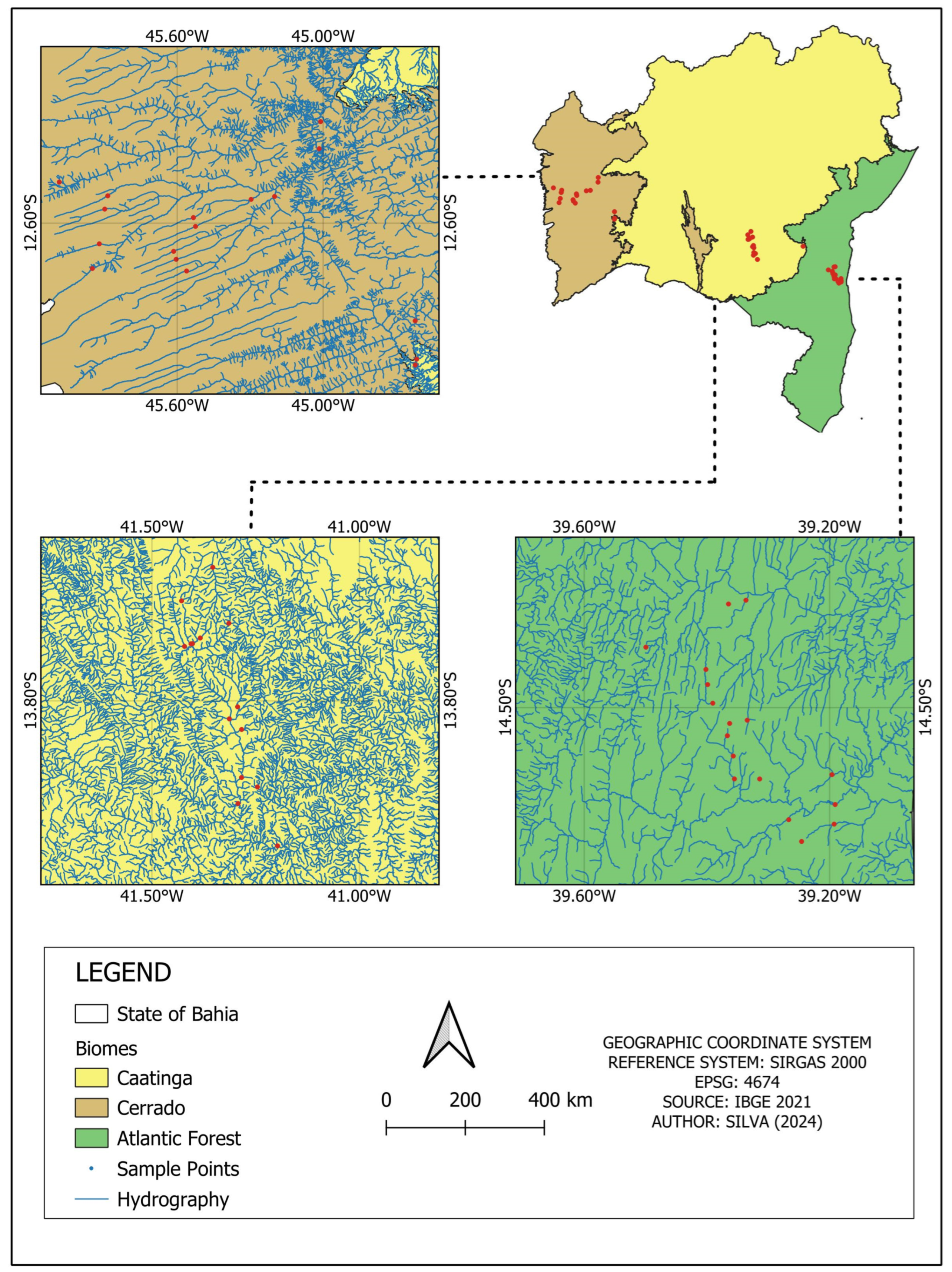

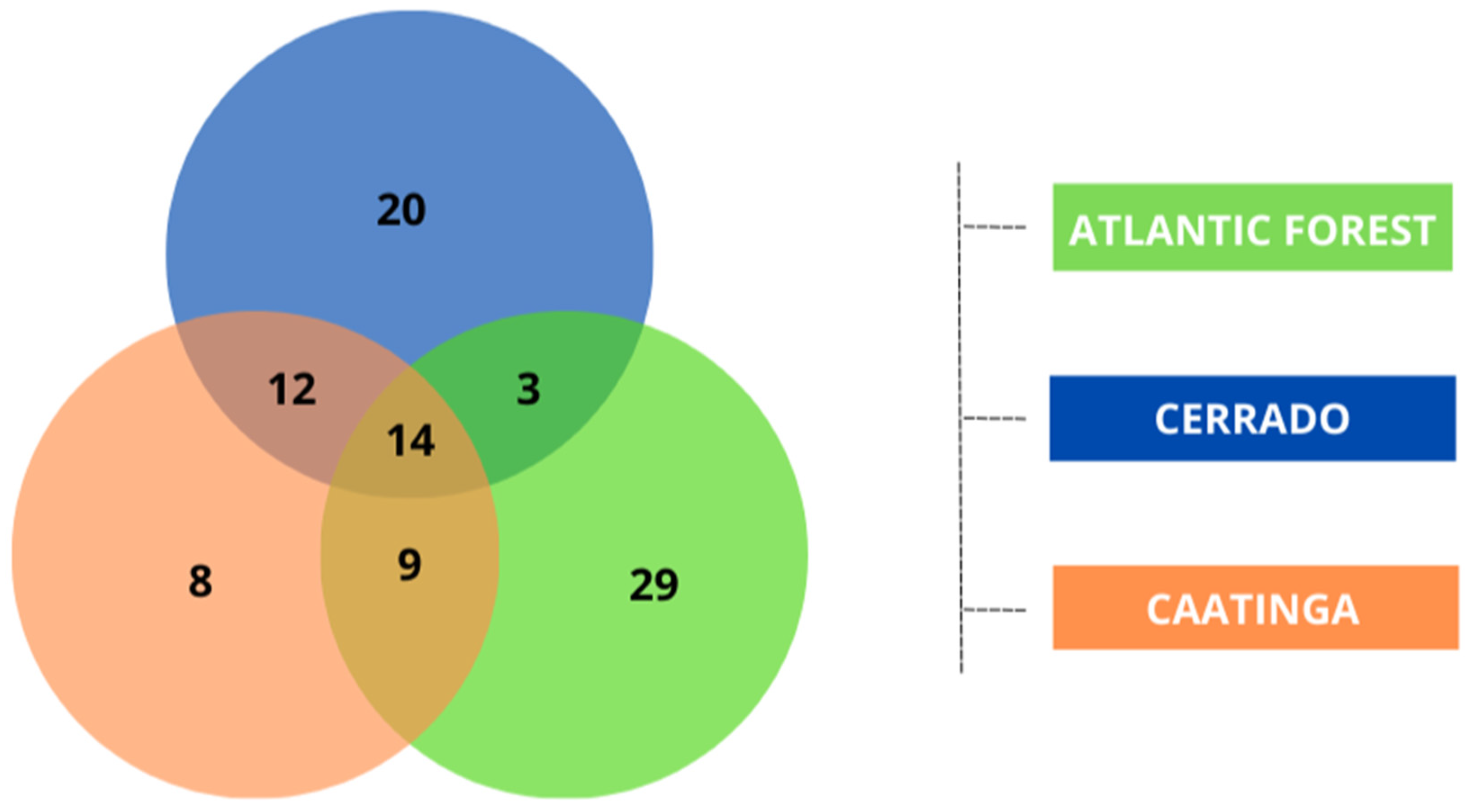
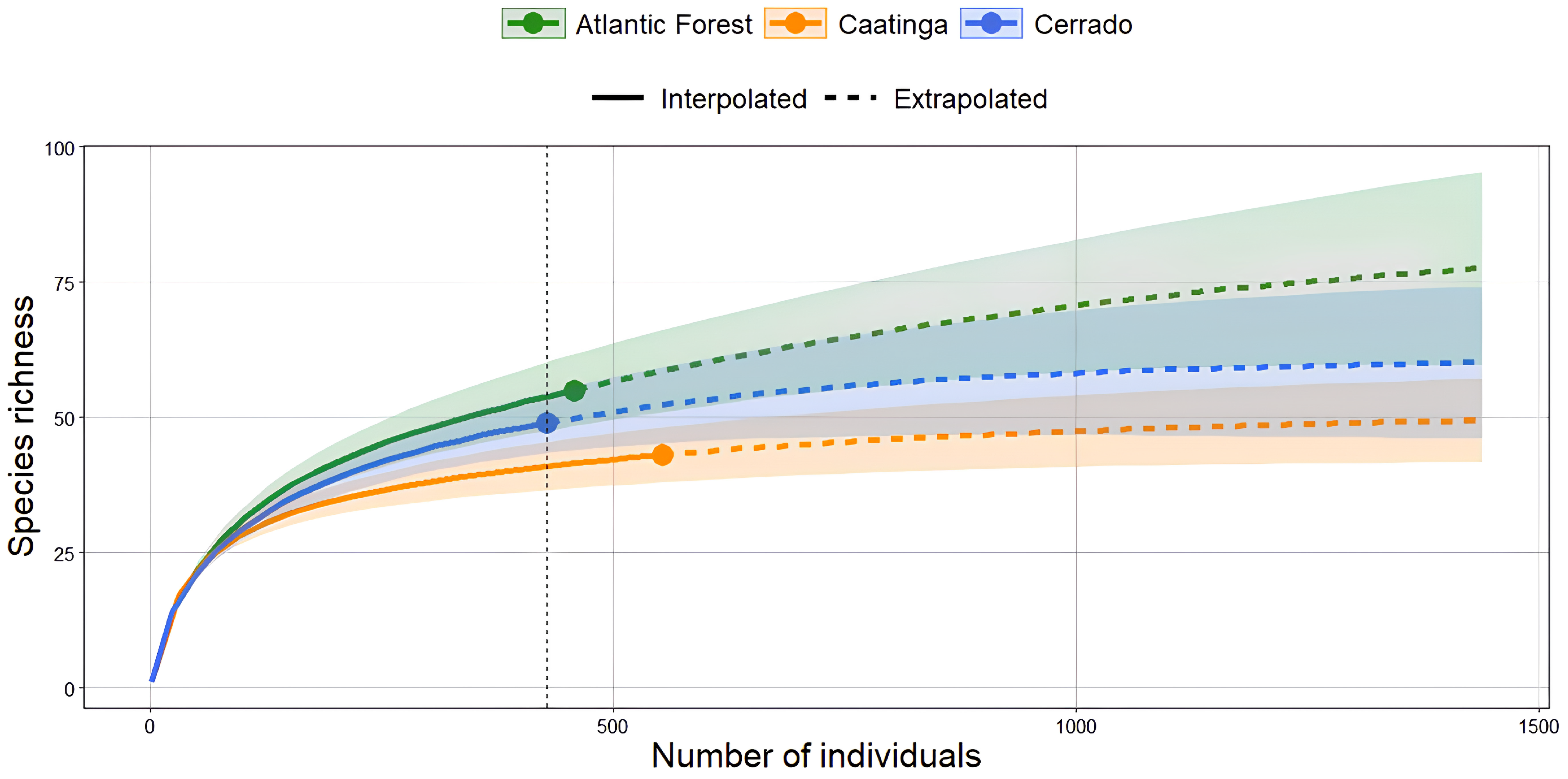

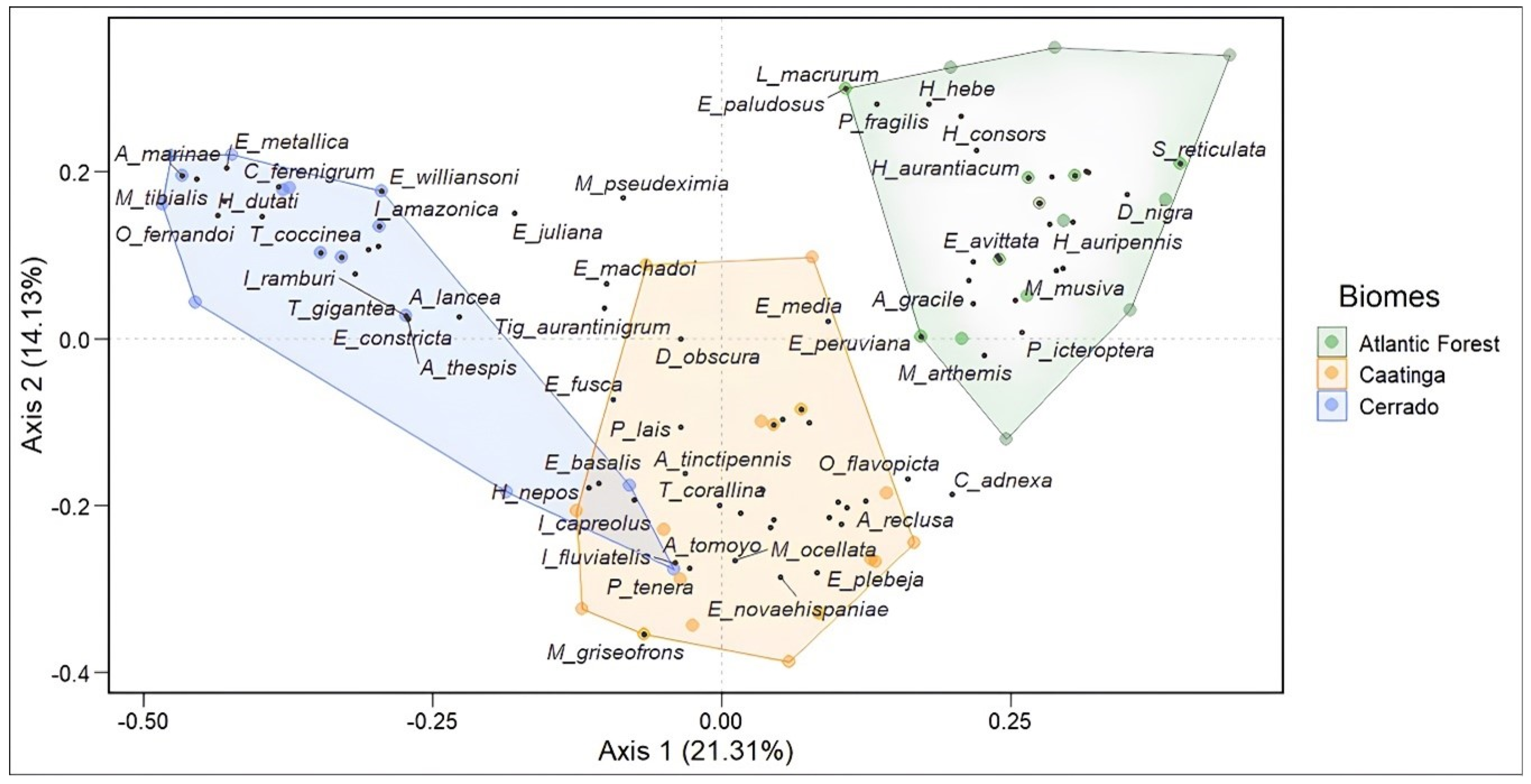
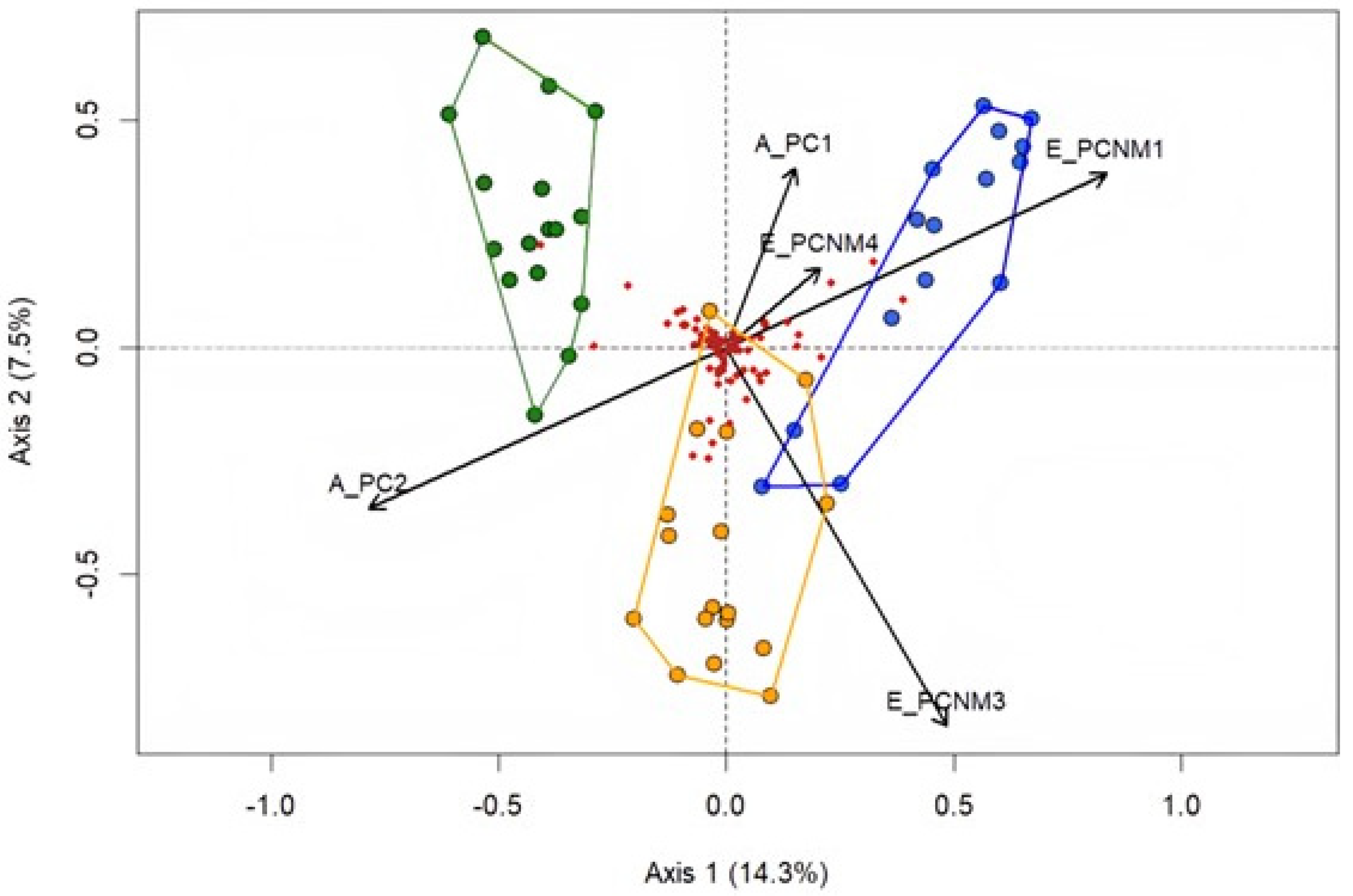
Disclaimer/Publisher’s Note: The statements, opinions and data contained in all publications are solely those of the individual author(s) and contributor(s) and not of MDPI and/or the editor(s). MDPI and/or the editor(s) disclaim responsibility for any injury to people or property resulting from any ideas, methods, instructions or products referred to in the content. |
© 2025 by the authors. Licensee MDPI, Basel, Switzerland. This article is an open access article distributed under the terms and conditions of the Creative Commons Attribution (CC BY) license (https://creativecommons.org/licenses/by/4.0/).
Share and Cite
Teixeira, K.; Santos, A.d.S.; Vilela, D.S.; Ribeiro, C.; Rodrigues, M.E. The Importance of Different Biomes (Atlantic Forest, Cerrado, and Caatinga) in the Regional Structuring of Neotropical Dragonfly Assemblages. Diversity 2025, 17, 345. https://doi.org/10.3390/d17050345
Teixeira K, Santos AdS, Vilela DS, Ribeiro C, Rodrigues ME. The Importance of Different Biomes (Atlantic Forest, Cerrado, and Caatinga) in the Regional Structuring of Neotropical Dragonfly Assemblages. Diversity. 2025; 17(5):345. https://doi.org/10.3390/d17050345
Chicago/Turabian StyleTeixeira, Karolina, Acácio de Sá Santos, Diogo Silva Vilela, Cíntia Ribeiro, and Marciel Elio Rodrigues. 2025. "The Importance of Different Biomes (Atlantic Forest, Cerrado, and Caatinga) in the Regional Structuring of Neotropical Dragonfly Assemblages" Diversity 17, no. 5: 345. https://doi.org/10.3390/d17050345
APA StyleTeixeira, K., Santos, A. d. S., Vilela, D. S., Ribeiro, C., & Rodrigues, M. E. (2025). The Importance of Different Biomes (Atlantic Forest, Cerrado, and Caatinga) in the Regional Structuring of Neotropical Dragonfly Assemblages. Diversity, 17(5), 345. https://doi.org/10.3390/d17050345






